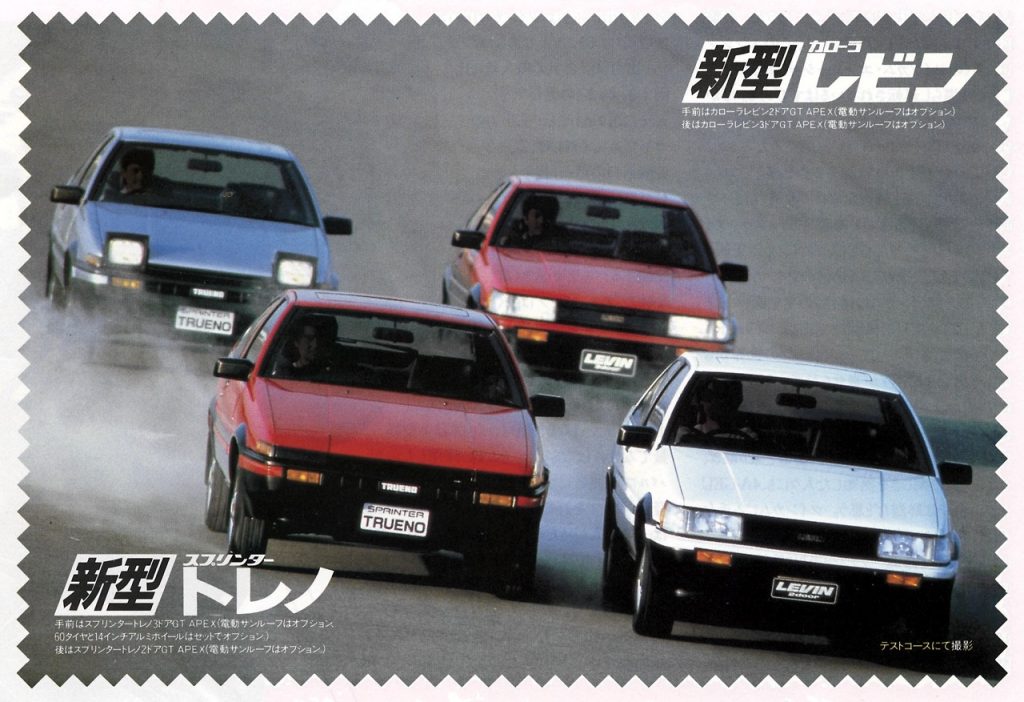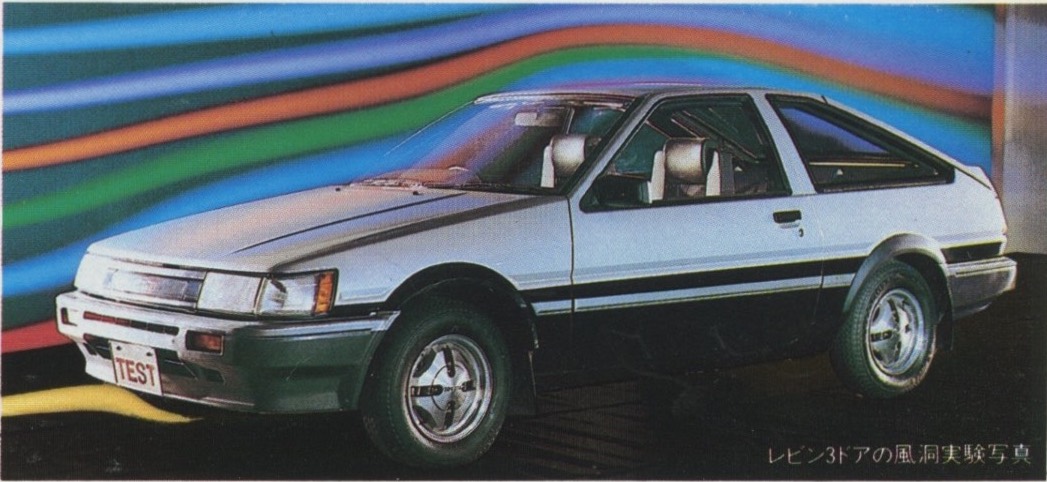With the arrival of the fifth Corolla and Sprinter, the Levin and Trueno AE86 featured two distinct body styles: a sporty looking two-door and a slippery looking three-door. This was different compared to the previous generations. In the fourth generation the Levin and Trueno were only a (top of the line) trim level on the three-door. The new Levin and Trueno had a very different appearance where the Levin retained fixed headlights and the Trueno gained popup headlights. I wondered how this would influence the drag-coefficient of both models and both body types. Time for another AE86 Trivia post!
Fixed or popup headlights

As said earlier, the Levin retained fixed headlights. Howerver, compared to the previous E70 generation they had become slanted to make the body sleeker. This made it more slippery for air to pass. After popup headlights being introduced on the Celica and Celica XX/Celica Supra two years earlier, the Trueno also received popup headlights with slightly more sloping hood. Naturally, this would be good for the AE86 drag-coefficient.
Levin rotating grill
The choice for the popup headlights was made by designer Michio Inoko to match the front-wheel-drive sedans more. Due to the front-wheel-drive engine layout, the engines in the Corolla and Sprinter sedans had a sloping hood. The popup headlights were his way to create a similar look and feel on the Trueno.
As the Trueno now featured the popup headlights, the Levin was also in need of a gimmick. It was decided by planning manager Mikio Kaneko to add a rotating grill exclusively to the Levin GT Apex trim level. This grill would improve the drag-coefficient when closed. However, when the car is driven spiritedly and the coolant temperature rises above 85 degrees Celsius, this grill would open up to increase airflow to the radiator. Naturally, the system was over-engineered and the team ensured there was no possibility of overheating if the mechanism failed.

AE86 drag coefficient
Even though the Trueno with its popup headlights appears much more streamlined than the Levin, both actually have the exact same drag coefficient. Both have 0.35 for the SR trim level, where the SR trim level is a three-door model. This is remarkable as the SR trim level lacks the rotating grill. Also, designer Michio Inoko wanted to lower the rear hatch a few millimetres. However, this proved to worsen the AE86 drag-coefficient and he reverted back to the original design.

So how do the Levin and Trueno AE86es fare compare to other cars then?
| Car | Cw value |
| Tesla Model S (2014) | 0.24 |
| Mazda RX-7 FC3S (1987) | 0.33 |
| Ford Sierra (1982) | 0.34 |
| Toyota Corolla Levin / Sprinter Trueno AE86 – 3-doors (1983) | 0.35 |
| Citroën CX (1974) | 0.36 |
| Ferrari Testarossa (1986) | 0.36 |
| Ford Escort Mk III (1980) | 0.37 |
| Mazda MX5 NA (1989) | 0.38 |
| Toyota Corolla Levin / Sprinter Trueno AE86 – 2-doors (1983) | 0.38 |
| Nissan Skyline GT-R BNR32 (1989) | 0.40 |
As you can see, the drag-coefficient of 0.35 slots the two cars right between the Citroën CX (0.36) and the Ford Sierra (0.34). Both cars have a pretty low drag coefficient and are from the same era. The fact that both the Levin and Trueno have the same drag coefficient actually makes sense. Drag-coefficient is determined by the frontal area of the car to a large degree. Both cars have the same dimensions and only differ slightly in shape there shouldn’t be much difference between the two.
Two-door AE86 drag-coefficient
What about the two-door you may think now. As the two-door lacks the slippery teardrop shape of the hatch, airflow after the rear window will be disturbed. This will cause a vacuum to exist. This is bad for the drag-coefficient and this is also what you see in the table above. All cars listed are hatchbacks or have a sloping rear end. The two door AE86 has a drag coefficient of 0.38 and this is equal to the Mazda MX5 NA and slightly better than the Nissan Skyline GT-R BNR32 (0.40). Both cars aren’t hatchbacks and therefore their drag-coefficient is a bit worse.
Conclusion
Now don’t get carried away and think this is another reason not to buy a two-door AE86. This is utter nonsense as the two-door body shape is much more rigid than the three-door hatchback. But it does show you Toyota’s thinking: the three-door hatchback is much more efficient on high(er) speeds on circuit racing and the two-door “hardtop” is much more rigid and thus much better for rallying.

Leave a Reply